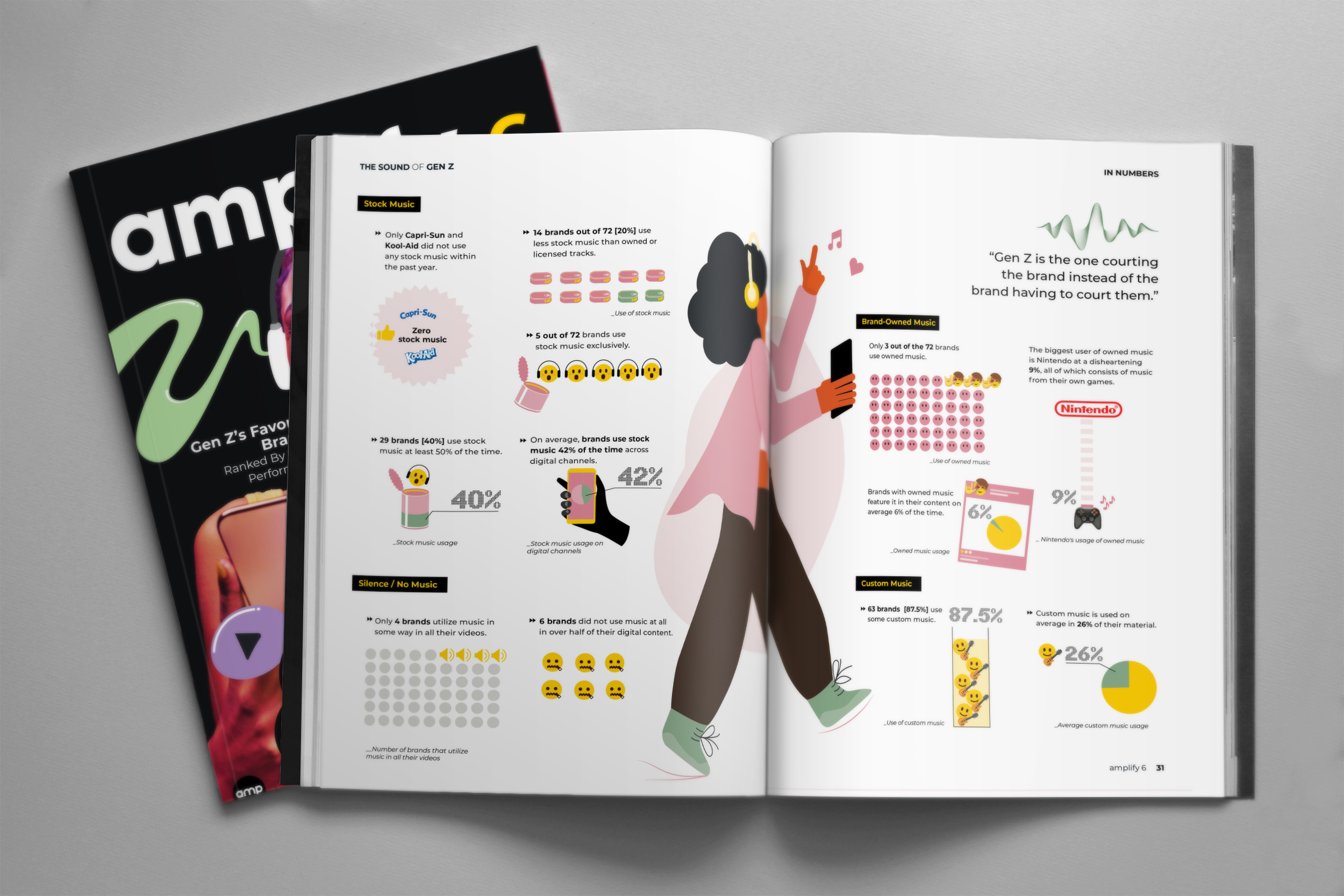A product of the digital age, Gen Z, individuals born between the years of 1997 and 2012, has caught the attention of marketers spanning all sectors in the Ad World. The highly analyzed and socially conscious generation prides itself on individuality and authenticity while appearing as an enigma to many brands and agencies across the board. More than a hot-button item or the latest marketing trend, brands want to convert these newly independent consumers into dedicated customers. Spotify has noted in its Culture Next Report that 65% of Gen Z agree that audio helps them experience a situation more deeply. This explains the vast importance of understanding how brands can sonically approach this demographic with both integrity and authenticity.
How do these brands sound, and what is their sonic strategy (if any)? Can Gen Z consumers be converted into sonic brand ambassadors, carrying brands' sonic assets across digital platforms? amp’s Research & Insights team set out to survey the generational landscape and determine sonic gaps, sonic solutions, and better brand approaches to target and connect with younger consumers through sound.

The Ranking: Gen Z’s Favorite and Most Sonically Efficient Brands
Activating amp’s AI-driven Sonic Hub® tool suite, alongside extensive desk research, social media monitoring, and analysis, the Research & Insights team ranked Gen Z’s top 72 favorite brands (according to Morning Consult) utilizing the same methodology as the annual amp Best Audio Brands report. Nintendo, Playstation, Capri-Sun, Sephora, and KitKat round out the Top-5 ranking, with Domino’s, Apple, Netflix, Coca-Cola, and Disney+ filling in the Top-10. Only 15 brands out of the 72 analyzed lay claim to any type of sonic asset, most of which are not part of a wider holistic sonic identity. Gen Z’s most revered brands are plagued by shockingly low sonic logo and brand-owned music usage, as well as high stock, custom, and licensed music usage. amp research has shown that Gen Z appears to be courting their own favorite brands, rather than responding to particular advertising efforts. Highly efficient brands in the sonic department include Capri-Sun, Nintendo, Apple, Nike, and Coca-Cola with high custom music and sonic logo usage; these brands also successfully appeal to Gen Z by establishing a personal connection with consumers.
Sonic Memes, Self-Branding, Viral Hacks, and Sonic Watermarking
Gen Z’s favorite brands have recognized the power of short-form content in capturing the eyes and ears of the younger generation. Driven by sound, platforms like TikTok have the ability to heighten brand memorability and recall through viral trends, especially when the content produced is original and brand-specific. Sonic memes are incredibly valuable cultural currency for brands in the digital space. According to amp research, 81% of Gen Z study participants recognized brand sounds that were used in a viral meme; this is almost double the 41% who recognized brand sounds outside of viral meme trends. This ultimately translated into Gen Z participants correctly connecting the viral sound to the brand over 50% of the time, showcasing the sizable impact of sonic memes. The importance of these sonic trends can also be seen in older sonic assets which have made a comeback via short-form video apps. Personalized sonic tags have also pervaded the same apps in the form of sonic watermarking, serving as minimal sonic assets for smaller brands looking to expand their marketing efforts through sonic branding.
Bjorn Thorleifsson, Head of Research & Insights at amp said:
“This is a particularly exciting issue of amplify as it is the first time we have looked into an audience demographic, rather than an individual sector. Understanding Gen Z as an audience is hugely important as it relates to all industries, as they represent the next wave of unique customers. At amp, we take a data-driven approach to understanding market trends, and our original research (thank you to Austin Coates, Hannah Cahill, Ji Hun, and Rex Hirschhorn), shows how Gen Z-favored platforms like TikTok are really changing the branding landscape through sound.”
A New Age of Collaborative Sonic Branding, and Sonic Quality Control
One of the largest disconnects between brands and the Gen Z audience revolves around the implementation step of the sonic branding process. Sonic branding when targeted to Gen Z must cultivate and encourage thought-provoking relationships with consumers. amp research has revealed that on average, Gen Z’s favorite brands use 100 more tracks per year in advertisements than brands found within amp’s Best Audio Brands 2023 index. The rise of short-form video has incentivized brands to push out large amounts of content, however, this quantity must be matched with quality to capture the attention of Gen Z, who notably values authenticity and relatability over trends and cultural fads.
Cheryl Guerin, Executive Vice President, Global Brand Strategy & Innovation at Mastercard said:
“An astounding 56% of Gen Z proudly identifies as creative, according to a recent Harris Poll. While creativity manifests in various forms, music tops the list, with 67% declaring it as their primary source of inspiration. In this landscape, brand relevance hinges on a commitment to understanding the consumer and supporting their wants and needs through authentic action.”
Are you wondering how you may be able to activate sonic branding solutions to more effectively market to Gen-Z? Are you interested in seeing how your brand stacks up sonically, or are you just looking to gain additional insights on Gen-Z’s in the sonic sphere? Download your copy of amplify “Gen Z” via www.ampsoundbranding.com/amplify-06 and get in touch with our team today.
Posted at MediaVillage through the Thought Leadership self-publishing platform.
Click the social buttons to share this story with colleagues and friends.
The opinions expressed here are the author's views and do not necessarily represent the views of